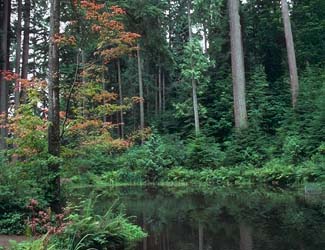 |
Metadata (Data about data or how the map was made)
Legend:
 = Core Habitat
= Core Habitat
 = Marginal Habitat
= Marginal Habitat
Predicted Distribution
Amphibians do not migrate as some birds and mammals, so the colored areas depict
the predicted range for the Red-legged Frog year-round. The habitats were identified
using 1991 satellite imagery, other datasets and experts throughout the state,
as part of the Washington Gap Analysis Project.
Distribution and Habitat Requirements
 Outside the breeding season, the Red-legged frog spends a lot of time away
from water and is frequently found along streams adjacent to woodlands (Leonard
et al., 1993). This species is a pond breeder and needs quiet waters and
aquatic vegetation for egg attachment. This frog breeds in floodplain pools
in the open areas of riparian hardwood forests. If residual downed logs from
a former conifer stand of trees and wetlands are present, it is possible
that it may also inhabit stands of alder trees.
Outside the breeding season, the Red-legged frog spends a lot of time away
from water and is frequently found along streams adjacent to woodlands (Leonard
et al., 1993). This species is a pond breeder and needs quiet waters and
aquatic vegetation for egg attachment. This frog breeds in floodplain pools
in the open areas of riparian hardwood forests. If residual downed logs from
a former conifer stand of trees and wetlands are present, it is possible
that it may also inhabit stands of alder trees.
Models
All the ecoregions west of the Cascades with marginal extensions into the East
Central Cascades and Southeast Cascades were selected. West of the Cascades
crest, all zones up to and including the Western Hemlock zone were core.
The Interior Douglas-fir, Grand Fir and Interior Western Hemlock zones were
marginal.
Lakes, rivers and riparian areas were good habitats. All open- and closed-canopy hardwood, hardwood/conifer, and conifer forests and all low-density developed residential areas including parks, golf courses, and wooded forests surrounded by development were considered suitable if adequate microhabitats were present.
Other
maps & Information:
|
Webpage designed by Dave Lester.